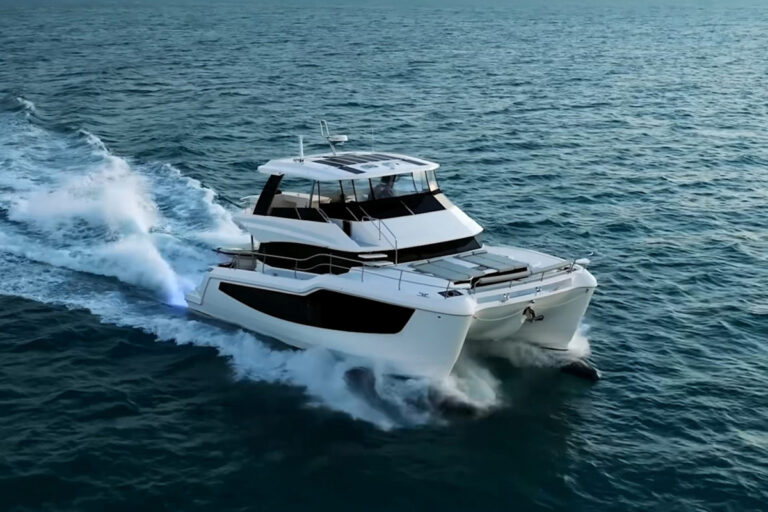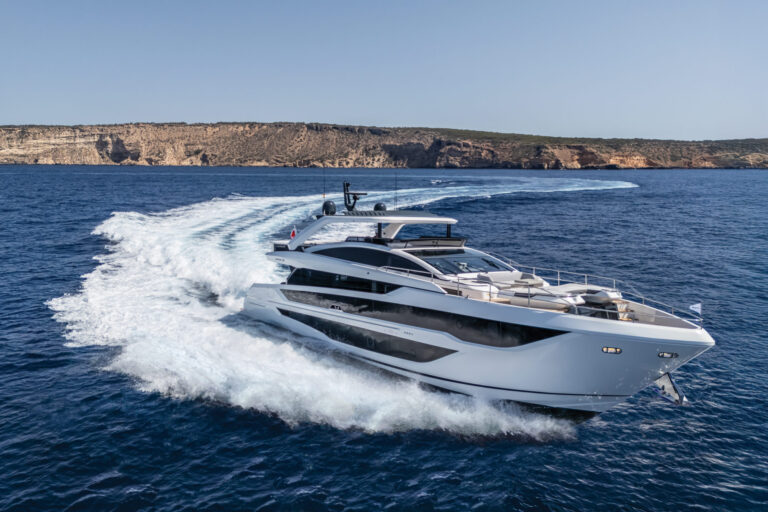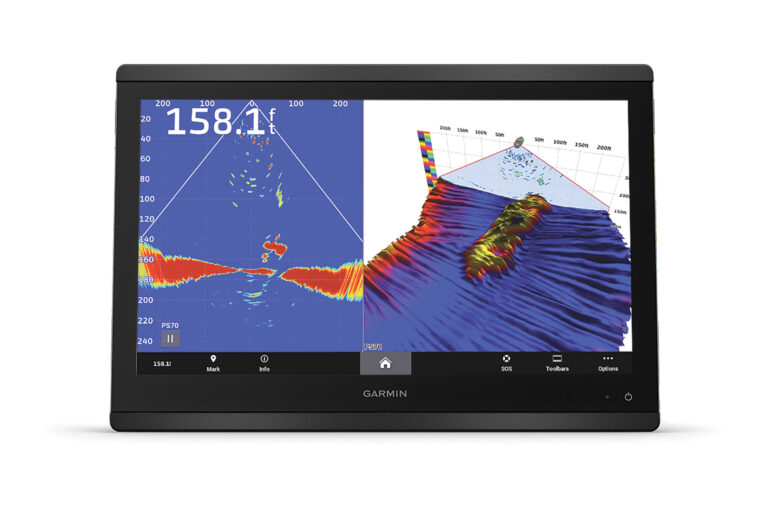Samantha Lin is so large and so unusual, as expedition yachts go, her new owner renamed her Dream. She’s remarkable not just for her length, which at 184 feet is not insignificant, but for her sheer volume and the capabilities offered by her extensive equipment list. She rises six levels from her keel to her flying bridge and carries everything from a 36-foot Predator sportfishing boat to a three-person Global yellow submarine on her mid-deck, abaft the fo’c’sle.
Dream was built as a Halter Expedition Series yacht but sold as a Trinity Global Explorer, with a bit more than a name change involved. Trinity Yachts was a division of Halter Marine, but following Halter’s sale to a larger commercial maritime company, Trinity was spun off. The new management is largely the same as the old. John Dane III, who ran the entire Halter operation for many years, and Billy Smith, longtime manager at Trinity, are now hands-on partners in Trinity Yachts along with Felix Sabates of Victory Lane renown. The yard, construction crew and in-house design staff remain largely the same. This is good news for yacht buyers, as Trinity houses seasoned professionals with excellent track records.
The quality of work can be seen in Dream. Her small features include red (fire), yellow (monitoring) and blue (telephone) alarm lights in the engineroom. Her bigger features include a ballast system that provides light displacement for fuel economy and heavy displacement for rough-weather seakeeping. She can carry as much as 370,000 pounds of ballast water in nine integral tanks at the turn of the bilge and at the bow. Not only do the tanks provide added stability and displacement on demand, they offer protection for the six main fuel tanks and two day tanks in the event of collision or hull damage. Between the tanks, a full-height pipe and access tunnel runs from the engineroom bulkhead to the collision bulkhead, fitted with two watertight doors along its length. Watertight doors are also fitted in corresponding bulkheads on the accommodations deck to maintain the watertight integrity of the yacht in case of uncontrolled flooding. In the engineroom, the Caterpillars are painted yellow instead of yacht-white, and the piping systems, rather than being an assembly of individual ball valves, are custom-cast integrated manifolds with hand-wheel controls. A 65kW Caterpillar generator is separately located in case the entire engineroom gets knocked out.
All the details highlight the priorities of this serious go-anywhere vessel. When you go anywhere, you have to be prepared for anything. The Coast Guard got it right: Dream.
Of course, true global exploration also means taking along a lot of stuff. Dream has more stowage than any yacht I can recall, and her accommodations are more spacious than usual, in all three dimensions. Her generous length and beam allow greater vertical spacing between decks, and the headroom makes it possible to outfit her with standard furnishings. If you are used to the smaller-scale furniture and built-ins found on most yachts, it takes a while to get used to the larger pieces on Dream. There is no question the opportunity to use stock items greatly broadens your options. It can also significantly reduce the cost of finishing the interior, which in this case is a grand display of dark wood paneling and light carpets, overheads and upholstery throughout.
There are five double guest staterooms belowdecks, all with en suite heads. The two staterooms aft have full tubs, while the other three are fitted with showers. Another room that would normally be a sixth guest suite is an exercise room aboard Dream, complete with an array of fitness equipment and another complete bath. On the other side of the watertight bulkhead that forms the forward boundary of the guest accommodations, a huge walk-in freezer and spacious laundry room adjoin the crew’s quarters. There are three twin cabins here, as well as a crew lounge and dry stores compartment. The crew galley and mess are up a flight of stairs in the fo’c’sle, abaft a large bosun’s locker.
In addition to the Predator and the sub, the open mid-deck carries a Shamrock 22 Cuddy, a Yamaha LS-2000 jet boat and a 15-foot Zodiac hard-bottom inflatable. Two Alaska Marine hydraulic cranes mounted on tall pedestals handle all the toys, and a cargo boom on the foremast handles stores.
The deckhouse aft has one open and three enclosed decks. The galley, dining room and saloon are on the main deck, along with an entry foyer and day head. The saloon is huge, with a grand piano that kind of disappears over in one corner. Here, as throughout the accommodations, an Ultra-Fog sprinkler system stands ready to spray a high-pressure mist to protect the space from fire.
One deck up is the most spacious owner’s accommodation you will ever see on a yacht. Forward of the king bed are a full-beam hanging locker and a dressing room. A double head with oversized whirlpool tub is to port, and there is a pantry with refrigerator, ice maker and sink to starboard. Aft, a room nearly as large as the main saloon serves as the owner’s dayroom, and there is a private open aft deck lounge area. Forward, a centerline ladder leads down to the mid-deck.
The next deck up carries the pilothouse, a well-equipped ship’s office and the captain’s cabin. A Portuguese bridge fronts the wheelhouse, and wing control stations are provided for docking and close-quarter maneuvering. Wisely, there are no owner or guest facilities on this deck to distract the crew from safely operating the vessel.
The top deck is open, dominated by a centrally situated hot tub forward of the mast base. There is considerable open area here for lounge chairs, or for an additional tender’s stowage.
Contact: Trinity Yachts Inc., (504) 283-4050; fax (504_ 284-7318; wssmith3@trinityyachts.com; www.trinityyachts.com








